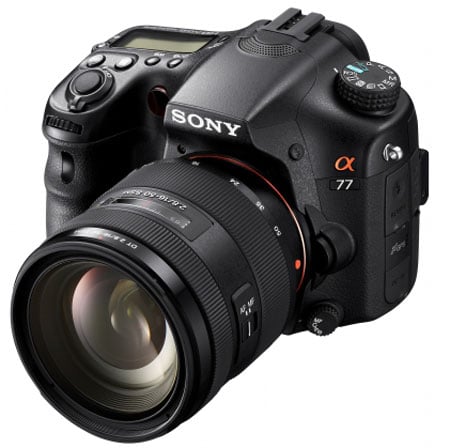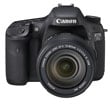Sony Alpha SLT-A77
-
-
Written by Gordon Laing
Verdict
While other manufacturers incrementally improve on the traditional SLR format Sony has shown it’s not afraid to innovate by introducing radical new designs into its line-up. The SLT-A77 takes the fixed mirror concept several steps towards becoming a compelling alternative to cameras with reflex mirrors.
But it’s not all about the SLT technology. The A77’s 24.3 Megapixel sensor is the highest resolution APS-C sensor available to date. At low ISO sensitivities the quality is comparable with the 18 Megapixel sensor of the Canon EOS 7D and though noise is an issue at high ISO sensitivities the SLT-A77 has both Multi-Frame Noise Reduction and Hand-held Twilight modes both of which produce a superior composite result to single frame high ISO shooting.
The new sensor can also capture Full HD video at progressive frame rates of 50 or 60fps and maintain continuous focus during movie shooting, something conventional SLR’s can’t do. Sony’s also equipped the SLT-A77 with full Manual exposure control for movie shooting and there are built in stereo mics as well as a standard jack to connect an external microphone.
But one of the biggest advantages conferred by the fixed mirror setup is fast continuous shooting with continuous AF. Boasting a top speed of 12fps with autofocus the SLT outperforms pro models like the EOS 1D Mark IV which costs over four times more. As you might expect there are compromises to be made. The buffer limits you to 14 RAW or Extra Fine JPEGs and write times can be lengthy unless you use a UHS-1 card. At 12fps you also effectively cede exposure control and are limited to shooting at or close to the maximum aperture – bit it’s still remarkable performance for the money.
Then there’s the SLT-A77’s viewing system which pairs the best EVF seen on any camera to date with a 3 inch main screen featuring a unique articulated mount that allows it to be positioned just about anywhere except out to the side. It sounds like Sony’s thought of everything, not to mention creating a nice bright kit lens to go with it, but before my final verdict, how does the A77 compare to rival models?
 |
Compared to Canon EOS 7D
Sony’s Alpha SLT-A77 sits between the Canon EOS 60D and EOS 7D in pricing, but is arguably pitched more against the latter in features, so that’s what I’ll compare it to here. Both are high resolution bodies with HD movie modes, fast continuous shooting and tough build, but there’s lots of differences to note.
In the Sony SLT-A77’s favour are 25% more Megapixels (24 vs 18), prodcing bigger images with no appreciable compromise in image quality at low ISO sensitivities. At higher sensitivities its innovative multi-frame noise reduction modes can greatly reduce visible noise without compromising detail. Both the A77 and EOS 7D feature 3in screens, but while the 7D’s is fractionally wider and more detailed, it’s fixed in position whereas the A77’s can be flipped-out and articulated to almost any angle.
Both cameras can film Full HD video, but the A77 wins on frame rates, shooting 1080p progressive at up to 60fps compared to 30fps on the 7D. The A77 can also continuously autofocus while filming, something which eludes traditional DSLRs like the EOS 7D. The A77 also enjoys built-in stabilisation which works with any lens you attach, while additionally scoring on gadgetry with a built-in GPS, and thanks to its EVF you can also compose movies at eye-level. There’s also five frame AEB compared to the usual three on the 7D.
In terms of continuous shooting, the Sony enjoys a quicker top speed of 12fps compared to 8fps, although the buffer is much smaller on the A77 (just 17 Fine JPEGs compared to the Canon which can keep shooting JPEGs until you run out of space), and if you want an adjustable aperture as you shoot, the A77’s speed drops to the same 8fps as the Canon.
One of the biggest differences regards the viewfinder: electronic on the A77 vs optical on the EOS 7D. This is a tough one to weigh up as there are pros and cons to both. Certainly the live view implementation on the A77 is much quicker, especially in regards to continuous autofocus, but sports, action and low light shooters will still prefer the speed and brightness of the 7D’s optical viewfinder. This will ultimately be very much a personal choice.
As discussed above, the EOS 7D is a much more capable camera when it comes to continuous shooting. Both cameras may employ 19 point AF systems, but again the 7D’s is more powerful with all 19 points being cross-type sensors, compared to 11 on the Sony, its battery will also comfortably out-live the A77, capturing around twice as many shots (approx 1000 vs approx 500).
Ultimately the A77 out-features the EOS 7D, but the Canon will out-perform it in a pro-sports environment with a much deeper buffer, more powerful AF system, and an optical viewfinder which allows you to follow the action. It is a more serious camera for photographers who demand that degree of performance, and despite its age still comes highly recommended. But for those who are satisfied with shorter bursts, the A77 is likely to be a tough rival, and Sony’s clever bundling of a classier lens for much the same kit price will have many seriously considering a move from a traditional DSLR.
See my Canon EOS 7D review for more details
Compared to Sony Alpha SLT-A65
The closest model to the SLT-A77 is the SLT-A65, launched alongside it. The A65 is a more affordable version, which lacks some of the bells and whistles, but still delivers a number of the same core capabilities. I’ll start with the things both models have in common.
Both share the same 24 Megapixel APS-C sensor with a 100-16000 ISO range and 25,600 ISO option using Multi-Frame Noise Reduction. Both share built-in stabilisation. Both share the same movie modes with 1080p at up to 60fps and AVCHD 2.0 encoding. Both cameras also share the same 3in VGA screen and XGA OLED viewfinder for composition.
So far so similar, but the higher-end A77 sports a number of benefits over the A65. Both cameras can shoot very quickly, but the A77’s top speed is 12fps to the A65’s 10fps, although it should be noted the buffer size on both is the same, and the speed with support for variable aperture is also the same at 8fps. The A77’s AF system is much more sophisticated with 19 AF points, 11 of which are cross-type sensors, compared to the 15-point system of the A65 with three cross-type sensors. The fastest shutter speed on the A77 is 1/8000 compared to 1/4000 on the A65, the fastest flash sync is 1/250 compared to 1/160, and the A77 supports five frame AEB, compared to three on the A65.
The A77’s body is tougher with magnesium alloy panels, sports two control dials to the A65’s one, features an upper LCD screen that’s lacking on the A65, and offers an additional degree of screen articulation allowing it to peek over the head and face the subject. The A77 also features AF Fine Tune to correct for front or rear focusing, a flash sync socket for studio lighting, and allows you to select upper and lower limits for the Auto ISO range, not to mention having a 50 ISO option and an Extra Fine JPEG setting. The kit lens option for the A77 is also the very classy new 16-50mm f2.8 SSM compared to the somewhat pedestrian 18-55mm f3.5-5.6 on the A65.
That’s quite a lot in the A77’s favour, and it’ll almost certainly swing it for higher-end enthusiasts, but the critical selling point of the SLT-A65 is delivering the same core features at a much lower price: indeed, costing around 40% less for the body alone, the A65 is one of the best-featured cameras in its class. It’s also smaller and lighter than the A77.
Look out for my upcoming review of the Sony Alpha SLT-A65.
Sony Alpha SLT-A77 verdict
The SLT-A77 builds on the foundations laid by the SLT-A33 and A55. If there were any doubts that a camera with a fixed semi translucent mirror and continuous live view could outperform traditional SLRs then Sony has laid them to rest with the A65 and A77. Some features are pivotal, not least of which is the ultra-high reolution OLED EVF. Sure footed and versatile AF, fast continuous shooting, reliable in-camera stabilisation and tough build quality, 5 frame AEB and a PC sync port for connecting to studio lighting all add to it’s semi-pro credentials. On top of that, there are all the additional features that will appeal to those for whom photography isn’t a living or even the main event; built-in GPS, 3D and Panorama modes and 1080p50/60 video with continuous AF.
As a package it adds up to more than the sum of its parts and, more importantly, more than what’s on offer from Canon and Nikon in this price range. As a consumer camera I don’t think I’m sticking my neck out to predict that the SLT-A77 will be a phenomenal hit. As a true semi-pro model though I’m not so sure. For fast action environments the A77’s EVF, good as it is, and the compromises involved in 12fps shooting will place it second to traditional but more confident models like the EOS 7D, despite its slower frame rate.
There’s one other aspect of the SLT-A77 that’s easily overlooked in the light of all the other technology advances, but will almost certainly play a part in making it a success and that’s the 16-50mm f2.8 SSM kit lens. It may not have the reach of Canon’s 18-135mm or Nikon’s 18-105mm, but it has some key features that add to the overall attractiveness of the SLT-A77 as a high end consumer model. Like the A77 body it’s moisture sealed, solidly engineered and feels like a pro lens. Finally, and crucially, it maintains its f2.8 maximum aperture throughout the zoom range allowing for excellent low light performance as well as narrow depth of field effects.
The SLT-A77 is priced between the Canon EOS 60D and EOS 7D though closer to the latter and it’s a little more expensive than Nikon’s mid-range D7000. It’s not difficult to see it gaining market share from those models, but it’s equally possible that the SLT-A77’s main appeal will lie with those yet to make a commitment to one manufacturer or another and who are open to the possibilities that the SLT architecture provides in terms of its balance of performance features and price. The SLT-A77 is the best SLT Sony has yet produced and, arguably, the one that puts SLT on a par with SLR, an achievement for which it deserves to be highly recommended.
Bad points | Scores (relative to 2011 Semi-Pro DSLRs) |
 | ||
Build quality: Image quality: Handling: Specification: Value:
Overall: |
18 / 20 18 / 20 19 / 20 19 / 20 17 / 20
91% | |||






